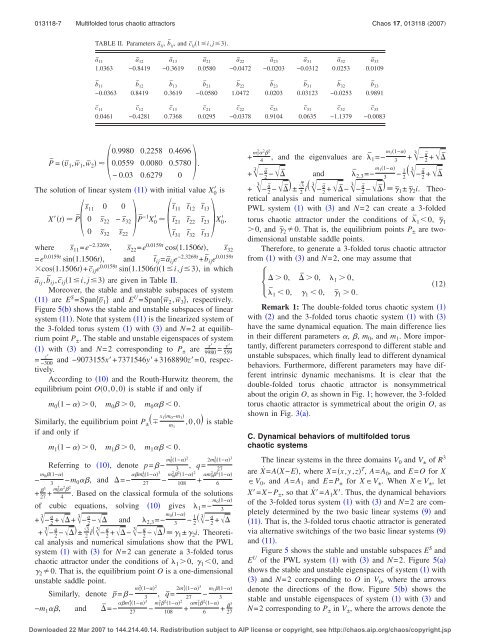Multifolded torus chaotic attractors: Design and implementation
Multifolded torus chaotic attractors: Design and implementation
Multifolded torus chaotic attractors: Design and implementation
Create successful ePaper yourself
Turn your PDF publications into a flip-book with our unique Google optimized e-Paper software.
013118-7 <strong>Multifolded</strong> <strong>torus</strong> <strong>chaotic</strong> <strong>attractors</strong> Chaos 17, 013118 2007<br />
TABLE II. Parameters ā ij , b¯ij, <strong>and</strong> c¯ij 1i, j3.<br />
ā 11 ā 12 ā 13 ā 21 ā 22 ā 23 ā 31 ā 32 ā 33<br />
1.0363 −0.8419 −0.3619 0.0580 −0.0472 −0.0203 −0.0312 0.0253 0.0109<br />
b¯11 b¯12 b¯13 b¯21 b¯22 b¯23 b¯31 b¯32 b¯33<br />
−0.0363 0.8419 0.3619 −0.0580 1.0472 0.0203 0.03123 −0.0253 0.9891<br />
c¯11 c¯12 c¯13 c¯21 c¯22 c¯23 c¯31 c¯32 c¯33<br />
0.0461 −0.4281 0.7368 0.0295 −0.0378 0.9104 0.0635 −1.1379 −0.0083<br />
0.9980 0.2258 0.4696<br />
P¯ = v¯1,w¯ 1,w¯ 2 <br />
0.0559 0.0080 0.5780 .<br />
− 0.03 0.6279 0<br />
The solution of linear system 11 with initial value X 0 is<br />
XtP¯ s¯11 0 0<br />
<br />
t¯12 t¯13<br />
0 s¯22 − s¯32 P¯ −1 X 0 t¯11<br />
t¯21 t¯22 t¯23 0 ,<br />
0 s¯32 s¯22 t¯31 t¯32 t¯33X<br />
where s¯11 =e −2.3269t , s¯22 =e 0.0159t cos1.1506t, s¯32<br />
=e 0.0159t sin1.1506t, <strong>and</strong> t¯ij =ā ij e −2.3269t +b¯ije 0.0159t<br />
cos1.1506t+c¯ij e 0.0159t sin1.1506t1i, j3, in which<br />
ā ij ,b¯ij,c¯ij 1i, j3 are given in Table II.<br />
Moreover, the stable <strong>and</strong> unstable subspaces of system<br />
11 are E S =Spanv¯1 <strong>and</strong> E U =Spanw¯ 2,w¯ 3, respectively.<br />
Figure 5b shows the stable <strong>and</strong> unstable subspaces of linear<br />
system 11. Note that system 11 is the linearized system of<br />
the 3-folded <strong>torus</strong> system 1 with 3 <strong>and</strong> N=2 at equilibrium<br />
point P ± . The stable <strong>and</strong> unstable eigenspaces of system<br />
x<br />
1 with 3 <strong>and</strong> N=2 corresponding to P ± are<br />
= z<br />
−300<br />
9980 = y<br />
559<br />
<strong>and</strong> −9073155x+7371546y+3168890z=0, respectively.<br />
According to 10 <strong>and</strong> the Routh-Hurwitz theorem, the<br />
equilibrium point O0,0,0 is stable if <strong>and</strong> only if<br />
m 0 1− 0, m 0 0, m 0 0.<br />
x<br />
Similarly, the equilibrium point P ±<br />
<br />
1 m 0 −m 1 <br />
<br />
m 1<br />
,0,0 is stable<br />
if <strong>and</strong> only if<br />
m 1 1− 0, m 1 0, m 1 0.<br />
Referring to 10, denote p=− m 0 2 1− 2<br />
3<br />
, q= 2m 0 3 1− 3<br />
27<br />
− m 01−<br />
3<br />
−m 0 , <strong>and</strong> =− m 0 4 1− 3<br />
27<br />
− m 0 2 2 1− 2<br />
108<br />
+ m 0 2 2 1−<br />
6<br />
+ 3<br />
27 + m 0 2 2 2<br />
4<br />
. Based on the classical formula of the solutions<br />
of cubic equations, solving 10 gives 1 =− m 01−<br />
+ 3 − q 2 + + 3 − q 2 − <strong>and</strong> 2,3 =− m 01−<br />
3<br />
− 1 2 3 − q 2 + <br />
+ 3 − q 2 − ±<br />
3<br />
2 i 3 − q 2 + − 3 − q 2 − 1 ± 2 i. Theoretical<br />
analysis <strong>and</strong> numerical simulations show that the PWL<br />
system 1 with 3 for N=2 can generate a 3-folded <strong>torus</strong><br />
<strong>chaotic</strong> attractor under the conditions of 1 0, 1 0, <strong>and</strong><br />
2 0. That is, the equilibrium point O is a one-dimensional<br />
unstable saddle point.<br />
Similarly, denote p¯ =− m 1 2 1− 2<br />
3<br />
, q¯ = 2m 1 3 1− 3<br />
27<br />
− m 11−<br />
3<br />
−m 1 , <strong>and</strong> ¯ =− m 1 4 1− 3<br />
27<br />
− m 1 2 2 1− 2<br />
108<br />
+ m 1 2 2 1−<br />
6<br />
+ 3<br />
27<br />
3<br />
+ m 1 2 2 2<br />
4<br />
, <strong>and</strong> the eigenvalues are ¯ 1=− m 11−<br />
3<br />
+ 3 − q¯2 + ¯<br />
+ 3 − q¯2 − ¯ <strong>and</strong> ¯ 2,3=− m 11−<br />
3<br />
− 1 2 3 − q¯2 + ¯ <br />
+ 3 − q¯2 − ¯ ±<br />
3<br />
2 i 3 − q¯2 + ¯ − 3 − q¯2 − ¯ ¯ 1±¯ 2i.<br />
Theoretical<br />
analysis <strong>and</strong> numerical simulations show that the<br />
PWL system 1 with 3 <strong>and</strong> N=2 can create a 3-folded<br />
<strong>torus</strong> <strong>chaotic</strong> attractor under the conditions of ¯ 10, ¯ 1<br />
0, <strong>and</strong> ¯ 20. That is, the equilibrium points P ± are twodimensional<br />
unstable saddle points.<br />
Therefore, to generate a 3-folded <strong>torus</strong> <strong>chaotic</strong> attractor<br />
from 1 with 3 <strong>and</strong> N=2, one may assume that<br />
0, ¯ 0, 1 0,<br />
12<br />
¯ 1 0, 1 0, ¯ 1 0.<br />
Remark 1: The double-folded <strong>torus</strong> <strong>chaotic</strong> system 1<br />
with 2 <strong>and</strong> the 3-folded <strong>torus</strong> <strong>chaotic</strong> system 1 with 3<br />
have the same dynamical equation. The main difference lies<br />
in their different parameters , , m 0 , <strong>and</strong> m 1 . More importantly,<br />
different parameters correspond to different stable <strong>and</strong><br />
unstable subspaces, which finally lead to different dynamical<br />
behaviors. Furthermore, different parameters may have different<br />
intrinsic dynamic mechanisms. It is clear that the<br />
double-folded <strong>torus</strong> <strong>chaotic</strong> attractor is nonsymmetrical<br />
about the origin O, as shown in Fig. 1; however, the 3-folded<br />
<strong>torus</strong> <strong>chaotic</strong> attractor is symmetrical about the origin O, as<br />
shown in Fig. 3a.<br />
C. Dynamical behaviors of multifolded <strong>torus</strong><br />
<strong>chaotic</strong> systems<br />
The linear systems in the three domains V 0 <strong>and</strong> V ± of R 3<br />
are Ẋ=AX−E, where X=x,y,z T , A=A 0 , <strong>and</strong> E=O for X<br />
V 0 , <strong>and</strong> A=A 1 <strong>and</strong> E= P ± for XV ± . When XV ± , let<br />
X=X− P ± , so that Ẋ=A 1 X. Thus, the dynamical behaviors<br />
of the 3-folded <strong>torus</strong> system 1 with 3 <strong>and</strong> N=2 are completely<br />
determined by the two basic linear systems 9 <strong>and</strong><br />
11. That is, the 3-folded <strong>torus</strong> <strong>chaotic</strong> attractor is generated<br />
via alternative switchings of the two basic linear systems 9<br />
<strong>and</strong> 11.<br />
Figure 5 shows the stable <strong>and</strong> unstable subspaces E S <strong>and</strong><br />
E U of the PWL system 1 with 3 <strong>and</strong> N=2. Figure 5a<br />
shows the stable <strong>and</strong> unstable eigenspaces of system 1 with<br />
3 <strong>and</strong> N=2 corresponding to O in V 0 , where the arrows<br />
denote the directions of the flow. Figure 5b shows the<br />
stable <strong>and</strong> unstable eigenspaces of system 1 with 3 <strong>and</strong><br />
N=2 corresponding to P ± in V ± , where the arrows denote the<br />
Downloaded 22 Mar 2007 to 144.214.40.14. Redistribution subject to AIP license or copyright, see http://chaos.aip.org/chaos/copyright.jsp













